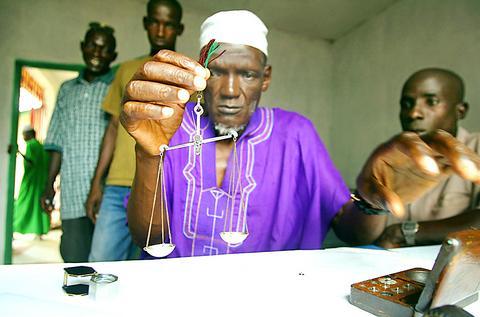De Beers, the world's largest diamond producer, has agreed to plead guilty to criminal price-fixing, a court official and lawyer involved in the case said Friday. The move ends a decadelong case and paves the way for the company to return to the US after an absence of nearly half a century.
The company is expected to plead guilty on Tuesday before Judge George Smith of US District Court in Columbus, Ohio, said Keith Mayton, a clerk in that court. He said the company faced a maximum fine of US$10 million.
"The court is set to take a guilty plea from De Beers," Mayton said.

PHOTO: AP
The agreement comes after months of negotiations and will enable De Beers to re-establish itself in the US, the most lucrative market for diamonds, as it looks to new markets and shifts its business focus in response to its declining grip on the production of rough diamonds.
For much of its 124-year history as the dominant force in diamonds, De Beers, has been accused of price-fixing and other anti-competitive conduct.
The company, founded by Cecil Rhodes and other investors in 1880, came under criticism from US officials during World War II for refusing to provide industrial diamonds for the war effort and faced antitrust cases brought by the Justice Department in 1945, 1957 and 1974. Those actions forced it to leave the American market, and it had to use intermediaries to get its products into the country.
The latest case was filed in 1994 after a three-year investigation. The indictment accused De Beers of violating the Sherman Antitrust Act by fixing the price of industrial diamonds.
The government contended that General Electric, another huge maker of industrial diamond products, conspired with a subsidiary of De Beers to fix the world prices of industrial diamonds in 1991 and 1992.
The two companies were accused of exchanging price information through Philippe Lotier, a French businessman. Lotier was both a major GE diamond customer and a director of a company affiliated loosely with De Beers.
At the time, the Justice Department was unable to prosecute De Beers because its operations were overseas and it refused to subject itself to the jurisdiction of an American court.
After a five-week trial, Smith threw out the criminal charges against GE. He concluded at the end of the government's case that prosecutors did not have sufficient evidence to prove a price-fixing scheme.
The prosecution's star witness was a former GE executive who was dismissed by the company for what it said was poor performance. Other government witnesses from GE provided some helpful evidence but also damaged the prosecution's case by maintaining that they did not think there was a conspiracy. Smith said that the government had failed to prove that Lotier had been working on behalf of De Beers when he received price information from GE and provided GE with information on De Beers' prices.
The apparent weakness of the government's case discouraged De Beers from seeking a settlement even though the failure to resolve the case has hampered the company's ability to do business in the US.
Antitrust law permits the imposition of a maximum fine of US$10 million, or twice the gain or loss caused by a price-fixing scheme. The indictment does not specify how much the scheme cost purchasers of industrial diamonds.
Steven Sunshine, one of the company's antitrust lawyers in the US, did not return a call seeking comment on Friday. Nicola Wilson, a spokeswoman for De Beers in Johannesburg, where the company is based, declined to comment until after the conclusion of the court proceeding next Tuesday.

To many, Tatu City on the outskirts of Nairobi looks like a success. The first city entirely built by a private company to be operational in east Africa, with about 25,000 people living and working there, it accounts for about two-thirds of all foreign investment in Kenya. Its low-tax status has attracted more than 100 businesses including Heineken, coffee brand Dormans, and the biggest call-center and cold-chain transport firms in the region. However, to some local politicians, Tatu City has looked more like a target for extortion. A parade of governors have demanded land worth millions of dollars in exchange

An Indonesian animated movie is smashing regional box office records and could be set for wider success as it prepares to open beyond the Southeast Asian archipelago’s silver screens. Jumbo — a film based on the adventures of main character, Don, a large orphaned Indonesian boy facing bullying at school — last month became the highest-grossing Southeast Asian animated film, raking in more than US$8 million. Released at the end of March to coincide with the Eid holidays after the Islamic fasting month of Ramadan, the movie has hit 8 million ticket sales, the third-highest in Indonesian cinema history, Film

Taiwan Semiconductor Manufacturing Co’s (TSMC, 台積電) revenue jumped 48 percent last month, underscoring how electronics firms scrambled to acquire essential components before global tariffs took effect. The main chipmaker for Apple Inc and Nvidia Corp reported monthly sales of NT$349.6 billion (US$11.6 billion). That compares with the average analysts’ estimate for a 38 percent rise in second-quarter revenue. US President Donald Trump’s trade war is prompting economists to retool GDP forecasts worldwide, casting doubt over the outlook for everything from iPhone demand to computing and datacenter construction. However, TSMC — a barometer for global tech spending given its central role in the

Alchip Technologies Ltd (世芯), an application-specific integrated circuit (ASIC) designer specializing in server chips, expects revenue to decline this year due to sagging demand for 5-nanometer artificial intelligence (AI) chips from a North America-based major customer, a company executive said yesterday. That would be the first contraction in revenue for Alchip as it has been enjoying strong revenue growth over the past few years, benefiting from cloud-service providers’ moves to reduce dependence on Nvidia Corp’s expensive AI chips by building their own AI accelerator by outsourcing chip design. The 5-nanometer chip was supposed to be a new growth engine as the lifecycle